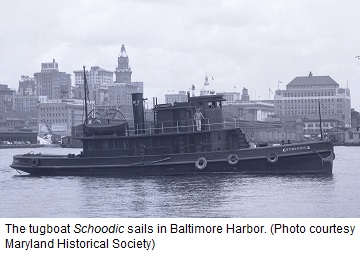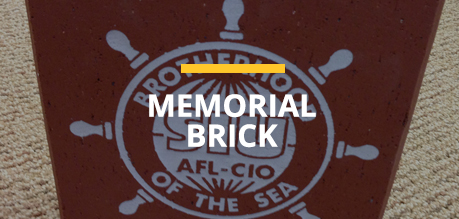Editor’s note: This article was penned by Rafael Alvarez, a writer and former SIU member based in Baltimore. Alvarez is also the son of a retired, longtime SIU member who sailed with the union for more than three decades. Anyone with information about long-lost mariner Harrison Worrell or the tug Schoodic is asked to contact Alvarez via email at [email protected].
 The last known whereabouts of marine engineer Harrison “Happy” Worrell was on board an East Coast tug called the Schoodicin late December of 1939. Worrell’s family never saw him again. And though a body didn’t surface – nor was a death certificate discovered – an insurance benefit of a thousand dollars was paid out to his widow, a woman with many layers of secrets named Myrtle Whittier Joyner Worrell.
The last known whereabouts of marine engineer Harrison “Happy” Worrell was on board an East Coast tug called the Schoodicin late December of 1939. Worrell’s family never saw him again. And though a body didn’t surface – nor was a death certificate discovered – an insurance benefit of a thousand dollars was paid out to his widow, a woman with many layers of secrets named Myrtle Whittier Joyner Worrell.
Before compensating the alleged widow, Monumental Life argued in court papers, “Harrison Worrell is not dead.” Company investigators apparently were not able to prove this anymore than Myrtle could show that he was dead. The policy was issued just weeks before his disappearance on or about Dec. 26, 1939.
Insurance industry officials said it is virtually unheard of for a benefit to be paid without a death certificate.
Worrell was born in 1896 in Rollins Fork, Virginia, a small town between the Chesapeake Bay and the Rappahannock River. Blue-eyed, sandy-haired, he was in his early 40s when he vanished, and had several failed relationships resulting in children by other women at the time he went missing.
Not much more is known about Worrell beyond a string of Baltimore addresses, his registration for the draft during World War I and his application for a Social Security card.
His story is a seafaring puzzle worthy of Conrad and Conan Doyle, one further muddied by Myrtle’s lickety-split marriage to a “boarder” in her house before tears shed for Worrell (if there were any) were dry.
“I want to know if the insurance company actually investigated anything,” and if so, what they found out, said Terry Grove Barbera, Worrell’s biological granddaughter who spent most of her life thinking that the boarder – Clyde Martin Hatt (1914-1978) – was her grandfather.
Similarly, her mother – LaVerne Worrell Grove, now 81 and living in a suburban Baltimore nursing home – believed that Clyde Hatt was her father until she was in the seventh grade.
One day in 1949 or 1950, the adolescent LaVerne was rooting around in the basement of the family home on Mosher Street in West Baltimore and found a box of papers – among them, her birth certificate naming Harrison Benjamin Worrell as her father. When LaVerne asked her mother about it, Myrtle evaded the question.
The moment has vexed LaVerne ever since. “I was hurt by something I didn’t know anything about,” said LaVerne, who long ago spent $300 on a detective who turned up a few out-of-touch relatives but no firm answers.
“It was a feeling of being alone,” she said, “of wondering, ‘Who am I.’”
Several years ago, the investigation was taken up by Barbera, raised in Baltimore and now living near Seattle. Her list of unanswered questions is lengthy.
Did Worrell die on board the tug?
Was it a boating accident that went unreported?
Did Worrell hurl himself overboard from grief over the death by pneumonia of his infant daughter Geraldine (La- Verne’s younger sister), who passed away that June?
Was his disappearance reported to the police? Was there any accounting by the family that owned the Schoodic – Nora and H.B. Messenger of Caroline County on Maryland’s Eastern Shore?
Was the Coast Guard involved?
Did a newspaper somewhere in the mid-Atlantic report that a body had washed up on shore fitting the description of Worrell?
A habitué of the rough stevedore saloons that once crowded the South Baltimore waterfront, might Happy have said the wrong thing to the wrong guy?
Or, most troubling of all, said Barbera, “Did he just walk away from his family one day and make it look like an accident?”
Barbera has chased most of these leads without satisfaction. She is particularly seeking cooperation from Monumental Life, now known as Transamerica Premier Life Insurance Company, headquartered in Cedar Rapids, Iowa. So far, they have not been helpful.
Named for a peninsula in Down East, Maine, the Schoodic was built near Portland in the Pine Tree State in 1907 and was owned by the Messenger Transportation Company of Federalsburg between the World Wars.
The tug was primarily used to tow petroleum bunkers between Baltimore and Philadelphia. In 1942, she sailed via canals near Lake Okeechobee in Florida to bring a new barge to the Chesapeake.
Forty years after she was built, the Schoodic was destroyed by fire in April of 1947 near Drum Point off the shores of southern Calvert County in Maryland.
Barbera’s labors began as a simple pastime, the building of a family tree. It grew and came to focus on Harrison Worrell for her mother, “a woman who has lived with this hole in her identity most of her life, who was crippled for being told it was improper to ask for the truth from her own mother.
“My interest in solving the mystery of Harrison’s disappearance is to round out the story while Mom is still alive,” she said. “If nothing else, I might be able to give her this last gift.”





Comments are closed.